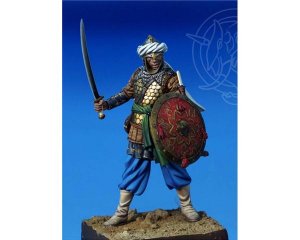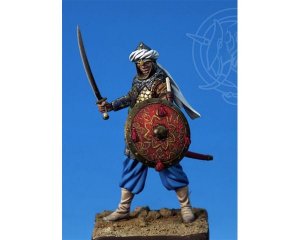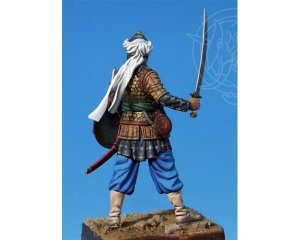





Ref.: ROME-54104

Muslim Warrior XIII C. Muslim warrior XIII century History: Muslims are people who believe in the Islamic faith. Since 1000 B.C. the inhabitants of the Arabian peninsula have been called Arab. In Arabic the word means nomad. Other etymologies see this name as being linked to the Hebrew word arabah, meaning desert, or ereb, which means mixture. In the VII century A.D., after the conversion to the Islamic religion, brought about by Mahomet, the peoples of Arabia managed to unite and spread all over the world, in such a way that by the end of the same century Muslims became the masters of a huge territory extending from the Atlantic to India and from southern Arabia to central Asia. Historical tradition has established that the term Arabs does not indicate only the peoples living in the Arabian peninsula , but all the inhabitants of Islamic territories who, starting from the first century of the Hegira, used Arabic as the means of communication and cultural expression, under the guidance and authority of the Caliphs. These were the successors of Mahomet as well as being the religious and political authorities in the Muslim world. Mahomet’s first successor was Abu Bakr in 632. He belonged to the Rashidun (justly guided) dynasty, and was the promoter of the cruel wars whose aim was to occupy the regions which refused Islamic authority. Abu Bakr became the undisputed head of the whole Arabian peninsula, thus assuring the survival of Islam. Romeo Models presents its 13th century Muslim horseman. This century saw the triumph of the Fourth Crusade after the capture of Constantinople, but also the defeat of the Fifth Crusade by the Muslims. King Louis IX of France occupied Egypt, but he was also forced to surrender. In this century the Mongols invaded Islamic territories and sacked Baghdad. Persians, and in particular those from the Khorassan region, thanks to their military skills, were always a special component of Islamic armies. The slightly curved sword, head-dress and the inlaid bronze bottle indicate that this figure is a Persian horseman. At the beginning of the Crusades, the Crusaders’ heavy cavalry routed the Muslims’ light cavalry. The latter, however, learnt to avoid frontal clashes and, thanks to their greater mobility and familiarity with the territories, they subsequently caused serious problems for the Crusaders’ heavy cavalry.